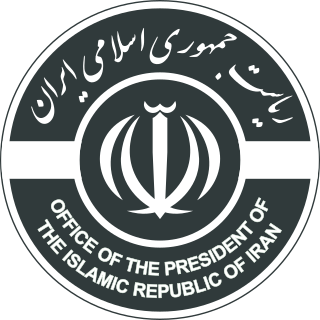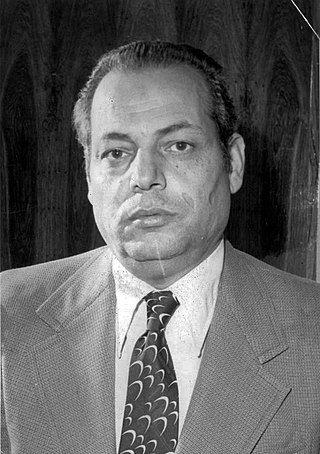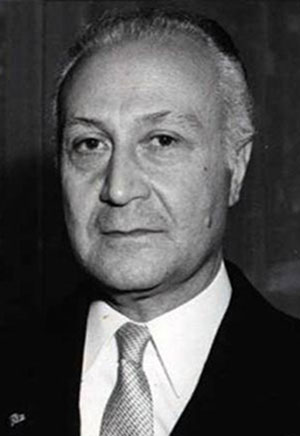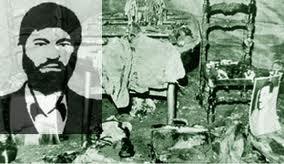Related Research Articles

The president of Iran is the head of government of the Islamic Republic of Iran and the second highest-ranking official,after the Supreme Leader. The first election was held in 1980 and was won by Abulhassan Banisadr. Masoud Pezeshkian currently serves as the President Of Iran,after being elected in the 2024 Iranian presidential election and being officially endorsed by the Supreme Leader.

Mohammad-Ali Rajai was an Iranian politician who served as the second president of Iran from 2 August 1981 until his assassination four weeks later. Before his presidency,Rajai had served as prime minister under Abolhassan Banisadr,while concurrently occupying the position of foreign affairs minister from 11 March 1981 to 15 August 1981. He died in a bombing on 30 August 1981 along with then-prime minister Mohammad-Javad Bahonar.

Mohammad-Javad Bahonar was a Shia Iranian theologian and politician who served as the Prime Minister of Iran for less than one month in August 1981. Bahonar and other members of Mohammad-Ali Rajai's government were assassinated by Mujahideen-e Khalq.

The prime minister of Iran was a political post that had existed in Iran (Persia) during much of the 20th century. It began in 1906 during the Qajar dynasty and into the start of the Pahlavi dynasty in 1923 and into the 1979 Iranian Revolution before being abolished in 1989.
Presidential elections were held in Iran on 24 July 1981 after the previous Iranian president,Abolhassan Banisadr,was impeached by the Majlis on 21 June and then sacked by the Supreme Leader,Ayatollah Khomeini,on 22 June. The elections occurred after the Hafte Tir bombing,which killed Mohammad Beheshti and dozens of other Iranian officials on 28 June 1981. This led to the election of Mohammad Ali Rajai,the previous prime minister,winning 13,001,761 votes out of the 14,573,803 votes cast,which was 89% of the votes. The vote turnout was 65.29%.

Ayatollah Mohammad Reza Mahdavi Kani was an Iranian Shia cleric,writer and conservative and principlist politician who was Prime Minister of Iran from 2 September until 29 October 1981. Before that,he was Minister of Interior in the cabinets of Mohammad-Ali Rajai and Mohammad-Javad Bahonar. He was the leader of Combatant Clergy Association and Chairman of the Assembly of Experts and also founder and president of Imam Sadiq University.

Karim Sanjabi was an Iranian politician,a member of The National Consultative Assembly. He was also a professor at Tehran University Law School and one of the leaders of Iran National Front and Iran Party. Sanjabi was also considered the Minister of Culture in the government of Mohammad Mosaddegh and the Minister of Foreign Affairs of Iran in the government of Mahdi Bazargan.

Sayyid Mostafa Agha Mirsalim is an Iranian engineer and conservative politician. He is currently member of the Expediency Discernment Council. He was formerly a member of Islamic Consultative Assembly from 2020 to 2024.
The Government of Mohammad-Javad Bahonar was the second government of Iran after the Iranian Revolution. During that time,Mohammad-Ali Rajai was president and Mohammad-Javad Bahonar was prime minister.

The Government of Mohammad-Ali Rajai was the first government of Iran after the Iranian Revolution. At that time,Abolhassan Banisadr was president and Mohammad-Ali Rajai was prime minister.

Ali Akbar Moinfar was an Iranian politician and the first oil minister of the Islamic Republic of Iran,serving briefly from 1979 to 1980. He later served as a member of the Parliament of Iran from 1980 to 1984,representing Tehran,Rey and Shemiranat.

Mohammad Javad Bagher Tondguyan was an Iranian engineer and petroleum minister under Prime Minister Mohammad-Ali Rajai from 2 September to 3 November 1980 when he was captured by the Iraqi forces in November 1980 during Iran-Iraq war.

Ahmad Mirfendereski was an Iranian diplomat,politician and the last minister of foreign affairs of the Shah era in Iran.

Abbas Ali Khalatbari,also known as Abbas Ali Khal'atbari,was an Iranian diplomat,who served as the minister of foreign affairs from 1971 to 1978. He was among the significant diplomats who shaped the foreign relations of Iran during the reign of Mohammad Reza Pahlavi. He is one of the Shah era politicians who were executed following the Iranian Revolution.

Amir Khosrow Afshar was an Iranian diplomat,who served as the minister of foreign affairs of Iran during the Shah era from 1978 to 1979.

Mohammad Montazeri was an Iranian cleric and military figure. He was one of the founding members and early chiefs of the Islamic Revolutionary Guard Corps. He was assassinated in a bombing in Tehran on 28 June 1981.

The office of Mohammad Javad Bahonar,Prime Minister of Iran,was bombed on 30 August 1981 by the People's Mujahedin of Iran (MEK),killing Prime Minister Bahonar,President Mohammad Ali Rajai,and six other Iranian government officials. The briefcase bombing came two months after the Hafte Tir bombing,which killed over seventy senior Iranian officials,including Chief Justice Mohammad Beheshti,then Iran's second-highest official. It is also reported that the director general of the prime minister's administration and an elderly woman bystander outside the building were killed.

Masoud Keshmiri was an Iranian militant who was the member of the People's Mujahedin of Iran (MEK) who infiltrated the Islamic Republican Party (IRP) and came up through the ranks,reaching the position of secretary of the Supreme National Security Council,before planting an incendiary bomb in his briefcase that blew up the Prime Minister's office in 1981. Victims of the explosion were President Mohammad-Ali Rajai and Prime Minister Mohammad-Javad Bahonar among others.

The cabinet led by Haj Ali Razmara was formed on 26 June 1950 and succeeded the cabinet led by Ali Mansur who was in office between April and June 1950. Razmara was a lieutenant general at the imperial army and was serving as the chief of the general staff when he was appointed by the Shah Mohammad Reza Pahlavi as the prime minister. It was the 33rd and first military cabinet in Iran since 1924. Behrooz Moazami also argues that it was one of the cabinets which did not follow the political agenda of the Shah in addition to the cabinets of Mohammad Mosaddegh and those of Ahmad Qavam in the Pahlavi rule. The Razmara cabinet ended on 11 March 1951 three days after the assassination of the prime minister.
References
- 1 2 "Foreign relations of the USA". Office of the Historian. 1980. Retrieved 22 October 2022.
Document 359
- 1 2 3 Luciano Zaccara (2016). "Iran's Permanent Quest for Regional Power Status". In Jacqueline Braveboy-Wagner (ed.). Diplomatic Strategies of Nations in the Global South: The Search for Leadership. New York: Palgrave Macmillan. p. 208. ISBN 978-1-137-45226-9.
- ↑ Luman Ali (2018). British Diplomacy and the Iranian Revolution, 1978-1981. Cham: Palgrave Macmillan. p. 156. ISBN 978-3-319-94406-7.